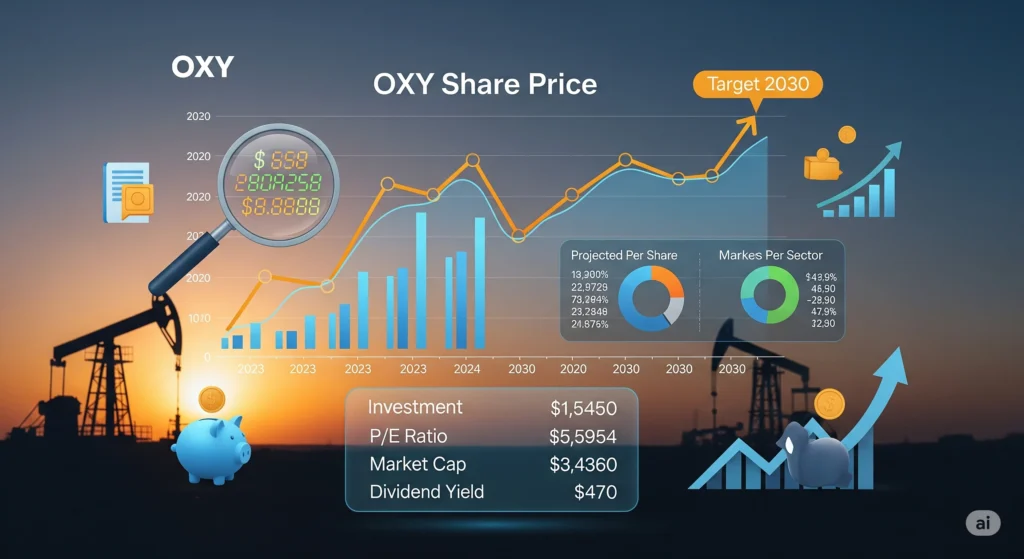AI Overview: Key Insights
- 2030 Price Target: Average estimate of $52.30, ranging from $28.78 to $75.81
- Current Status: Stock trading at $44.56 with 2.10% dividend yield
- Investment Outlook: Short-term challenges but long-term recovery potential
- Key Strength: Strong institutional backing from Berkshire Hathaway
- Primary Risk: High dependence on volatile oil prices
Table of Contents
- Oxy Share Overview
- Fundamental Analysis Of Oxy Share
- Last Few Years’ Performance Of Oxy Share
- Oxy Share Price Targets (2025–2050)
- Why is OXY Stock Falling?
- Oxy Share Price – Good to Buy?
- Factors Influencing Oxy Share
- Key Competitors of Oxy Share
- Expert Forecasts on the Future of Oxy Share
- How to Analyze and Buy Oxy Shares
- Frequently Asked Questions (FAQs)
- Conclusion
Investing in a well-established oil and gas company like Occidental Petroleum Corporation (OXY) demands a deep understanding of its fundamentals, financial performance, peer positioning, and credible expert forecasts. This article provides a highly detailed, data-driven, and up-to-date breakdown for anyone considering Oxy shares—whether you’re a total share market beginner or a seasoned investor seeking the latest reports from within the past 24 hours.
Oxy Share Overview
Occidental Petroleum Corporation (NYSE: OXY) is a major American oil and gas company with significant assets in the U.S. and internationally, primarily in
- Oil and Gas Exploration and Production,
- Chemical production,
- Midstream and Marketing.
Berkshire Hathaway (Warren Buffett’s investment vehicle) holds an ongoing, influential stake in Oxy, reflecting consistent institutional confidence—even as Oxy’s stock price has dipped well below previous highs.
Key Financial Figures (as of August 21, 2025):
- Market Cap: $45.12 Billion
- Shares Outstanding: 984.44 Million
- Current Price: $44.56
- 52-Week Range: $34.79 – $58.47
- Dividend Yield: 2.10% ($0.96 annual)
- 2024 Revenue: $26.73 Billion (TTM)
Oxy operates largely out of its robust asset base across the Permian Basin and other key U.S. shale and chemical manufacturing locations.
Fundamental Analysis Of Oxy Share
When analyzing OXY, focus on profitability, balance sheet strength, and its consistent pursuit of operational efficiency:
1. Profitability Metrics (Latest)
- Net Income (TTM): $1.73 Billion
- Earnings per Share (TTM): $1.71
- PE Ratio: 26.78
- Forward PE Ratio: 18.87
- Return on Equity (ROE, Q2 2025): 6.43%
- Return on Capital Employed (ROCE, August 2025): 5.37%
- Profit Margin (TTM): 9.00%
- Operating Margin (TTM): 14.87%.
2. Balance Sheet Health
- Total Assets (Q3 2024): $85.8 Billion
- Total Equity: $34.48 Billion
- Total Liabilities: $50.96 Billion.
3. Cash Flow
- Net Operating Cash Flow (Recent): Approx. $8.08 Billion.
4. Dividend Policy
- Current Dividend: $0.96/year yields 2.10% at current price.
Last Few Years’ Performance Of Oxy Share
Revenue Trend (2020–2025)
| Year | Revenue (Billion USD) |
|---|---|
| 2020 | 17.81 |
| 2021 | 25.96 |
| 2022 | 36.63 |
| 2023 | 28.26 |
| 2024 | 26.73 |
| 2025 | 27.15* (Latest TTM) |
The trend above shows revenue peaking in the post-pandemic commodity boom, then tapering off with recent oil price volatility, and stabilizing in the $26–28B range.
Profit Growth
- 2021–2022: Profits surged on commodity price recovery post-COVID-19.
- 2023–2024: Earnings declined, reflecting pressure from lower oil prices and some asset divestitures.
- 2025: Net income for TTM at $1.73B, showing stabilizing—but not accelerating—profit trends.
Sales Growth
Revenue growth was highly volatile:
- 2021: +45.7% YoY (recovery year)
- 2022: +41.1% YoY (commodity cycle peak)
- 2023–2025: Sharp decline as oil prices normalized and operational curtailments hit.
ROE Percentage
- Q2 2025 ROE: 6.43%
- 2024 (Annualized): 8.93%
- 2023: 18.51%
- 2022: 46.88% (exceptional year)
- ROE has normalized to mid-single digits in 2025, after peaking due to extraordinary oil prices.
ROCE Percentage
- August 2025: 5.37%
- Historically, Oxy’s ROCE was stronger in supercycle years but now aligns with a mature, capital-intensive business.
Total Expenditure Amount
- While public figures aren’t always broken out, Oxy’s expenditure aligns with its massive operational footprint—billions annually invested in:
- Upstream oil and gas production,
- Chemical expansion,
- Debt reduction through asset sales (nearly $1 billion of divestitures announced in August 2025).
- 2025 Capex and Opex: Stable but carefully managed due to declining margins and a strategic focus on debt.
The Net Cash Flow Amount
- Operating Cash Flow (latest): ~$8.08 Billion.
- Free Cash Flow: Remains robust, a key factor in sustaining Oxy’s dividends and debt paydown in a lower-oil-price environment.
Total Assets Amount
- Q3 2024 Total Assets: $85.8 Billion.
- Oxy’s asset base continues to underpin its global scale and capital market flexibility.
Oxy Share Price Targets (2025–2050)
Financial experts and AI-driven models use rigorous methods to estimate medium- and long-term share price targets based on earnings, energy prices, and sector outlook:
| Year | Avg Price Target | Low | High | % Change From Aug 2025 Price ($44.56) |
|---|---|---|---|---|
| 2025 | $38.02 | $18.62 | $57.42 | -14.7% |
| 2026 | $31.48 | $19.14 | $43.82 | -29.3% |
| 2027 | $60.60 | $36.53 | $84.67 | +36.0% |
| 2028 | $77.13 | $66.41 | $87.85 | +73.1% |
| 2029 | $74.36 | $66.28 | $82.45 | +66.9% |
| 2030 | $52.30 | $28.78 | $75.81 | +17.3% |
| 2040 | $99.24 | $92.74 | $99.24 | +128.8% |
| 2050 | $112.38 | $90.96 | $112.38 | +153.1% |
* There is significant volatility in projections due to the cyclical oil market and uncertain capital flows after 2030.
Why is OXY Stock Falling?
Recent Downtrend Factors (2024–2025):
- Oil Price Weakness: Declining benchmark oil prices reduce top-line and profit growth.
- Asset Sales: While reducing debt, large divestments can shrink future earnings power.
- Cost Pressures: Maintenance, inflation in oilfield services, and Gulf of Mexico curtailments.
- Market Sentiment: Technical analysis indicators (MACD, moving averages) point to a “Sell/Neutral” consensus lately.
- Underperformance: The stock is down approx. 9.3% YTD, and about 20% over 12 months.
Oxy Share Price – Good to Buy?
Short-Term (2025–2026):
Most technical indicators and analyst consensus currently rate OXY as a Hold or Sell due to short-term downside risk and a lack of strong upward catalysts.
Long-Term (2030–2050):
Oxy offers value for investors with a long-term, disciplined, and risk-tolerant outlook. Investors benefit from:
- Proven ability to generate free cash flow in tough cycles,
- Industry-leading asset base,
- Significant recovery upside if energy demand rebounds,
- Major institutional backing (Berkshire Hathaway),
- Dividend income as a cushion in down cycles.
Factors Influencing Oxy Share
- Oil & Gas Prices: Oxy’s fortunes are tightly tied to global commodity cycles.
- Debt Load/Asset Divestitures: Aggressive debt paydown improves strength but limits expansion.
- Carbon Management Technologies: Oxy’s investments in carbon capture and chemical plants could pay off long-term.
- Shareholder Returns Policy: Consistent dividends and share buybacks appeal to value investors.
- Regulatory Environment: U.S. and international energy policy shifts impact growth prospects.
Key Competitors of Oxy Share
| Company | Market Cap (USD) | Revenue (Latest, Billion USD) | PE Ratio | Dividend Yield | Key Focus |
|---|---|---|---|---|---|
| Occidental Petroleum (OXY) | $45.1B | $27.15 | 26.78 | 2.1% | Oil, Chemicals |
| Devon Energy (DVN) | ~$28B | ~$19.77 | 6.81 | 4.8% | Oil, U.S. Shale |
| Marathon Oil (MRO) | ~$10B | ~$7.67 | 9.62 | 1.5% | Oil, US Shale |
| Chevron (CVX) | $280B | $199.4 | 13.55 | 4.3% | Oil Supermajor |
| ConocoPhillips (COP) | $137B | $56.2 | 12.0 | 2.1% | Oil, Shale |
Oxy is a mid-tier heavyweight, less diversified than Chevron/Conoco, but with a larger footprint and more stability than smaller independents.
Expert Forecasts on the Future of Oxy Share
Bull Case:
- Oil Recovery: Global supply constraints or renewed demand can rapidly boost Oxy earnings.
- Asset Optimization: Divestitures free up cash for debt paydown and operational upgrades.
- Carbon Capture Upside: Oxy’s early-move investments may yield geopolitical and regulatory benefits.
- Warren Buffett Factor: Ongoing Berkshire Hathaway support acts as an endorsement for patient value investing.
Bear Case:
- Continued Oil Price Weakness: Further pressure on profitability.
- Asset Shrinkage: Ongoing divestitures may reduce the company’s growth potential.
- Cost Overruns: High operational and regulatory costs could erode margins.
- Market Volatility: Oxy remains vulnerable to broader market shocks or negative sentiment cycles.
How to Analyze and Buy Oxy Shares: Step-by-Step Guide for Beginners
If you’re new to share market investing, follow these structured steps:
Step 1: Understand the Business
- Deep-dive annual reports, investor presentations, and sector news.
- Study Oxy’s revenue drivers and its place in the oil and gas ecosystem.
Step 2: Analyze Fundamentals
- Review financial statements for net profit, ROE, ROCE, cash flow, asset valuations.
- Compare Oxy’s performance to sector averages.
Step 3: Monitor Share Price Targets
- Check latest analyst price targets for both short and long-term forecasts.
Step 4: Assess Market Sentiment
- Use technical analysis tools (such as RSI, MACD, moving averages) for short-term timing.
- Note that current sentiment is Neutral to Bearish due to weak momentum.
Step 5: Diversify Portfolio
- Don’t “bet the farm” on any single stock—add shares of competitors or even ETFs for risk reduction.
Step 6: Place an Order
- Use a trusted broker/online trading platform.
- Decide between a Market Order (buys instantly at best available price) or Limit Order (sets max price you’re willing to pay).
Step 7: Review Regularly
- Monitor your holdings and adjust based on market development, company performance, and global macro trends.
Frequently Asked Questions (FAQs)
Conclusion
Oxy (Occidental Petroleum) is a fundamentally strong, dividend-paying oil and gas company facing cyclical industry headwinds—but with a valuable asset base and strong institutional backing. For new investors, Oxy offers moderate risk, moderate dividend yield, and the potential for outperformance if global oil prices rebound. As always, remember to diversify, do your research, and think long-term.



